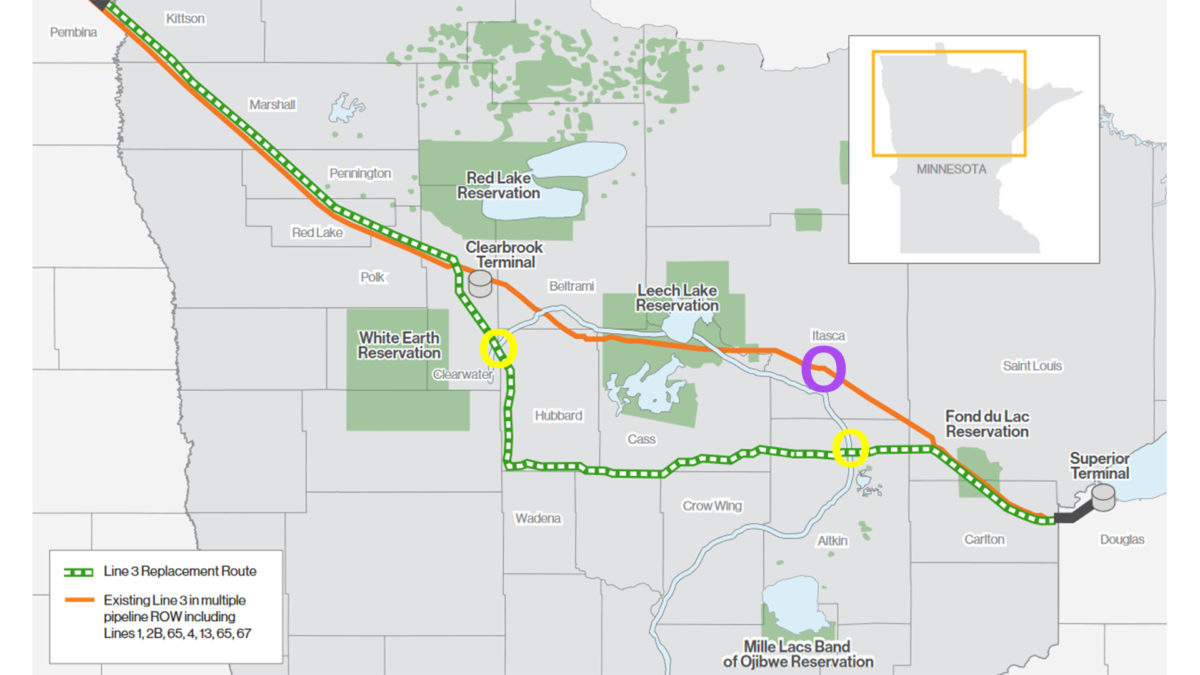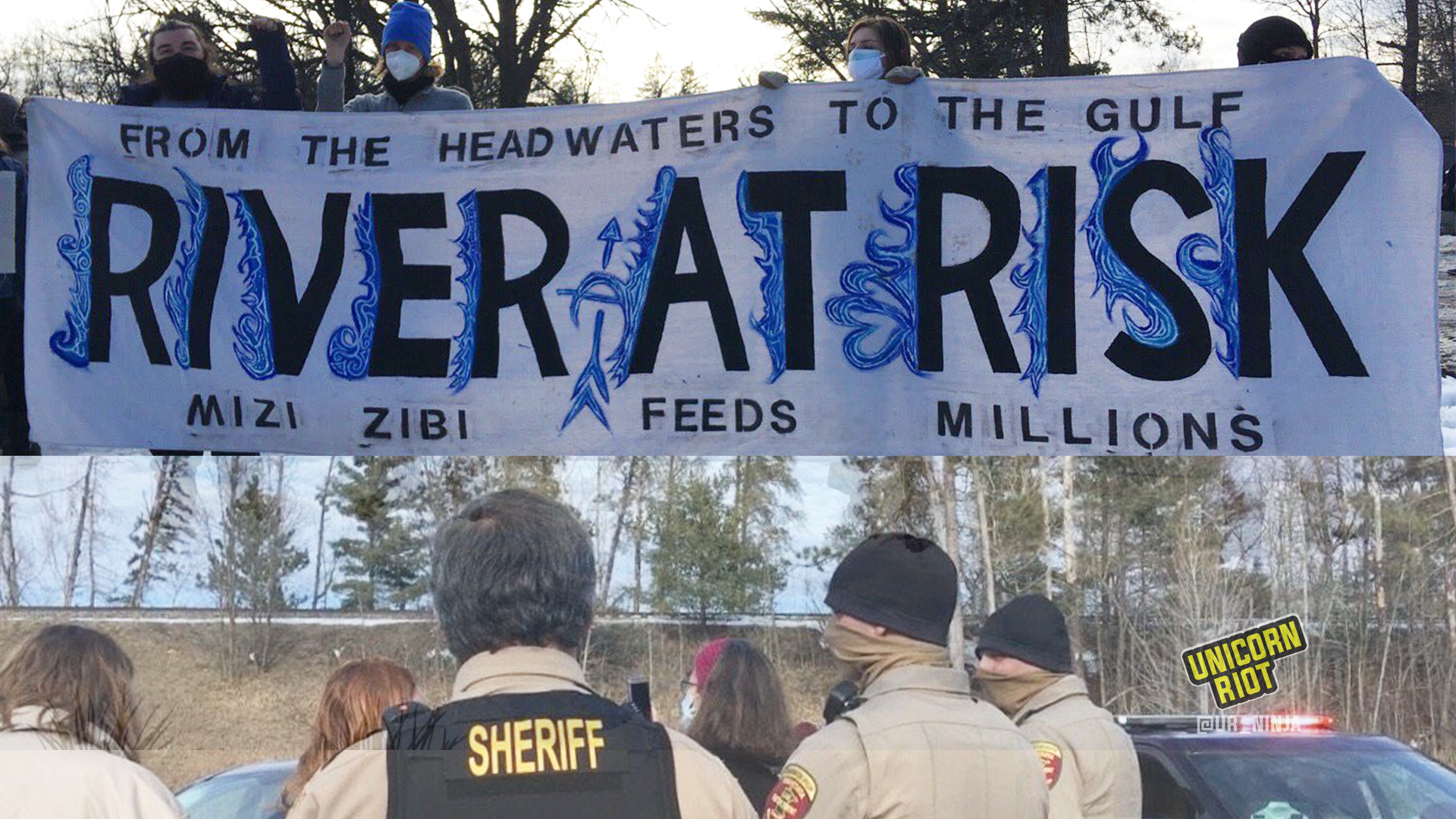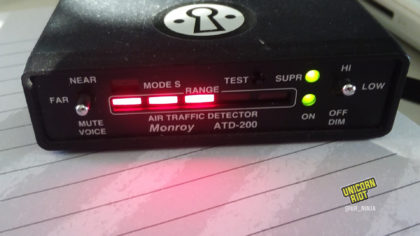70 Water Protectors Cited, 1 Arrested During Line 3 Commemorative Rally
Grand Rapids, MN – On March 3, 1991, Enbridge’s original Line 3 pipeline had the largest inland oil spill in North America—1.7 million gallons of tar sands crude polluted Prairie River, a tributary of the Mississippi River. To commemorate that tragedy and continue their resistance to the new Line 3, over 75 water protectors rallied near the location of the spill.
The rally, which consisted of speakers, chants, and holding banners and signs, was eventually surrounded by Itasca County Sheriffs and Minnesota State Troopers. The troopers told at least one water protector on video (shown below) that they were “conducting an investigation” and were gathering information. According to the Giniw Collective, 70 people were cited for “public nuisance” and one was arrested.
Resist Line 3 posted video of an interaction with one of the troopers:
Police threatening everyone with citations. Even those that never set foot on the public road. A clear violation of 1st amendment rights. pic.twitter.com/6eKG6wUqB9
— Resist Line 3 (@ResistLine3) March 3, 2021
Enbridge has reported 307 oil spills to federal regulators since 2002, totaling 2.8 million gallons of oil. Included in those figures is the 2010 Kalamazoo River spill of 840,000 gallons of tar sands.
According to Enbridge, the new Line 3 pipeline’s “expected initial capacity” is 760,000 barrels per day (bpd), yet other sources including research by Stop Line 3 (a campaign run by Honor the Earth), estimate the projected output to be up to 915,000 bpd.
If the pipeline is completed, hundreds of thousands of barrels of tar sands crude will be pumped from Edmonton, Alberta to Superior, Wisconsin, crossing 800+ wetlands, 200+ bodies of water, and the Mississippi River (twice).
In the map below, the two yellow circles show where Enbridge intends the new pipeline to cross the Mississippi River. The purple circle shows where the 1991 Grand Rapids spill occurred.

Nearly 150 water protectors have been arrested during rallies and direct actions since the final permit was approved by Minnesota regulators on November 30, 2020; the resistance movement only seems to be growing.
Biidwewegiizhagookwe (Tania Aubid), an Indigenous water protector and traditional harvester, has been on a hunger strike for two and a half weeks in protest of Line 3.
In our video below from a month ago, she describes why tar sands is dangerous:
“Tar sands is like the peanut butter oil; and that’s the scraping at the bottom of the barrel there. They’re gonna desecrate even more wild rice lakes out here, the manoomin we call, otherwise known as the wild rice, it’s the food that grows on water and that’s what I depend upon, my family depends upon, my tribe depends upon.”
On February 24, 2021, the Minnesota Indian Affairs Council wrote to Governor Walz, “as the elected leaders of the federally recognized Indian Nations in the state of Minnesota with one voice in solidarity with Red Lake and White Earth’s request to the Minnesota Court of Appeals to stay the construction of the Enbridge Line 3 pipeline.”
“As you are aware, the decision of the Minnesota Public Utilities Commission, which green lighted the pipeline construction, is currently on appeal to the Minnesota Court of Appeals . . .
Enbridge is now furiously constructing the pipeline, literally at five separate locations along the route in effort to construct as much of the pipeline as possible before the appellate court considers the substantive issues of the appeal. It is very frustrating to us that the PUC failed to grasp the severity of the living tribal cultural resources that are being damaged by the pipeline construction, as well as the PUC’s apparent inability to recognize the irreparable harm that will result to the environment.”
Minnesota Indian Affairs Council
In addition, an online petition by liberal climate group 350.org has garnered almost 250,000 signatures demanding President Joe Biden stop the Line 3 project.
During the Wednesday commemorative rally, a water protector spoke of the real-time connections of current struggles:
“With the approaching trial of Derek Chauvin, we uplift the interconnectedness of the struggle to protect treaty rights, clean waters, sacred space and Indigenous sovereignty with the right of all people to live in a world free of oppression and destruction of the earth.”
Water Protector
Photographs used in our feature collage taken by Giniw Collective.
Please consider a tax-deductible donation to help sustain our horizontally-organized, non-profit media organization:

Unicorn Riot's Line 3 Oil Pipeline Coverage:
- Landing Page for all Unicorn Riot Line 3 Resistance Coverage
- Minnesota Attorney General Keith Ellison Speech Disrupted by Water Protectors - October 8, 2021
- Over 50 Line 3 Pipeline Protesters Arrested Outside MN Governor’s Residence - September 22, 2021
- Police Break Up Ceremony and Indigenous-Led #StopLine3 Occupation - August 31, 2021
- Hundreds March from Governor Residence, Urge Chase Bank Defund Line 3 - August 31, 2021
- First Trial from Treaty People Gathering Ends in Acquittal - August 23, 2021
- Line 3 Opponent Sentenced to Thirty Days in Jail - August 19, 2021
- Enbridge Spills 10,000 Gallons of Line 3 Drilling Fluid - August 16, 2021
- Line 3 Fusion Center Data Declared Secret - August 4, 2021
- Judge Orders Sheriff to Halt Harassment of Line 3 Resistance Camp - July 24, 2021
- Water Protectors Occupy Work Sites and Lock Down to Line 3 Pipeline Construction - July 1, 2021
- Hubbard County Barricades Private Property, Imprisons Water Protectors - June 28, 2021
- Indigenous-Led Blockades Occupy Line 3 Pipeline Sites - June 10, 2021
- Rising Up to the Heat: ‘Treaty People Gathering’ Resists Line 3 Pipeline - June 7, 2021
- Activists Serve Denver Wells Fargo Eviction Notice - May 3, 2021
- Appealing Line 3 Pipeline: Supply and Demand at Root of Hearing - March 23, 2021
- Caravan Disrupts Line 3 Construction Routes, Carlton County Triggers Backlash - March 13, 2021
- Treaty Rights Asserted During Creation of White Earth Camp - March 13, 2021
- 70 Water Protectors Cited, 1 Arrested During Line 3 Commemorative Rally - March 4, 2021
- Bipod and Car Blockade Jam Up Line 3 Construction - March 2, 2021
- Three Lock Down Inside Line 3 Pipeline For 6+ Hours - Feb. 21, 2021
- Lockdown to Keep it in the Ground: Line 3 Resistance - Feb. 15, 2021
- Court of Appeals Denies Motion to Stop Line 3 - Feb. 3, 2021
- Opposition to Line 3 Mounts - Jan. 29, 2021
- Resistance to Line 3: Direct Actions Aim to Stop Construction - Jan. 11, 2021
- Enbridge Line 3 Construction Blocked by Activists in Northern Minnesota - Nov. 18, 2020
- Protests After Permits for Line 3 Oil Pipeline Approved - Nov. 17, 2020
- ‘No KKKops, No Pipelines’ Banner Dropped in Minneapolis - Oct. 6, 2020
- “Divest from Climate Change!” Chase Bank Branch Protested on Opening Day - Nov. 7, 2019
- March to Protect The Sacred on Indigenous People’s Day 2019 - Oct. 14, 2019
- Hundreds Rally in Opposition to Line 3 Tar Sands Pipeline in Minnesota - Sept. 28, 2019
- Direct Action in Minnesota as Line 3 Pipeline Approval Reversed - June 3, 2019
- Multi-Agency Task Force Prepares “Rules of Engagement” For Line 3 Protests - Feb. 11, 2019
- ‘Valve Turners’ Shut Down Enbridge Oil Pipelines in Minnesota - Feb. 4, 2019
- Arts, Culture, and Hip Hop Resist Line 3 as Lawsuits Against Approval Continue - Dec. 29, 2018
- Minnesota Police Train at Military Base as Line 3 Pipeline Protests Escalate - Oct. 25, 2018
- Judge Accepts Water Protectors’ Climate Change Necessity Defense - July 18, 2018
- Line 3 Oil Pipeline Approved By Minnesota Regulators - June 28, 2018
- As Line 3 Oil Pipeline Decision Looms, Indigenous Resistance Increases - June 26, 2018
- Interfaith Community Delivers Letter of Line 3 Opposition to Minnesota Government Offices - June 4, 2018
- Minnesota Public Utilities Commission Requests Line 3 Schedule Change - Jan. 10, 2018
- Rally Against Line 3 Minnesota Pipe Yards - Dec. 11, 2017
- Resistance to Line 3 Pipeline Seeks to Save Sacred Manoomin - Oct. 9, 2017
- Direct Action Ramps Up Resistance to Line 3 - Sept. 18, 2017


